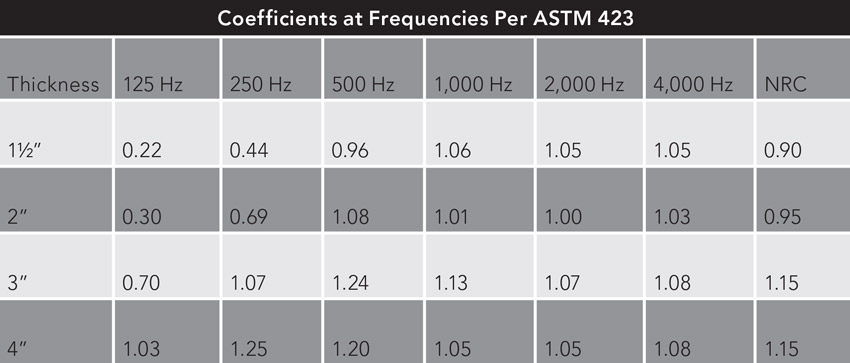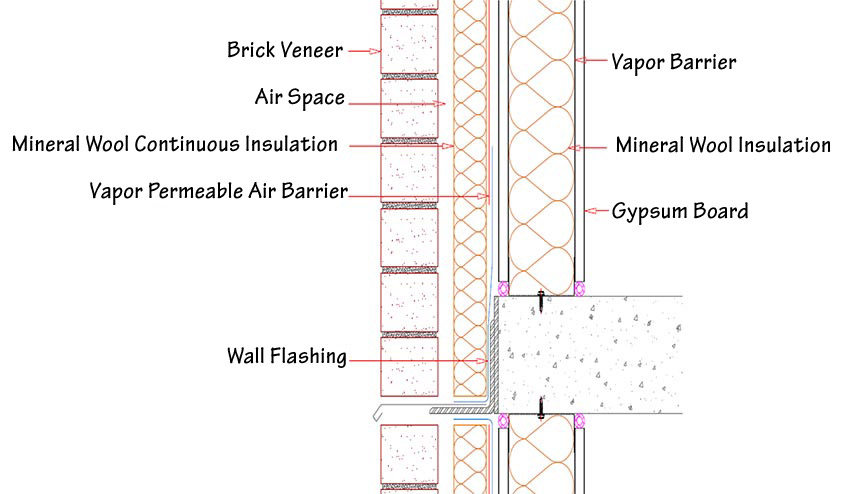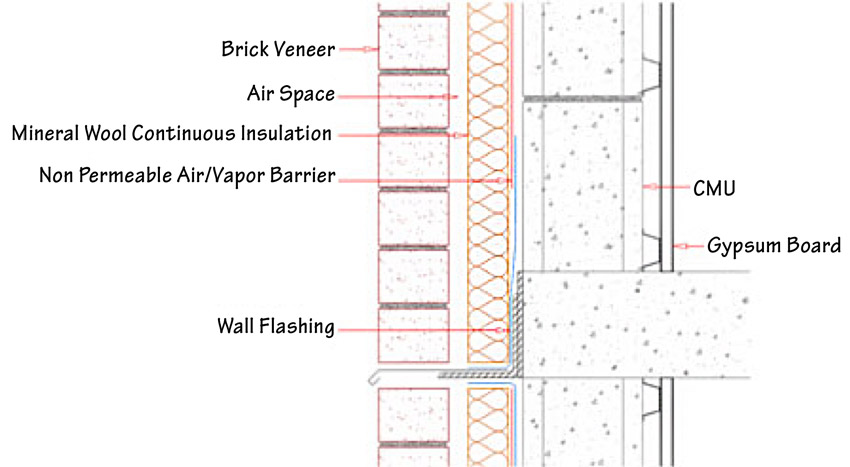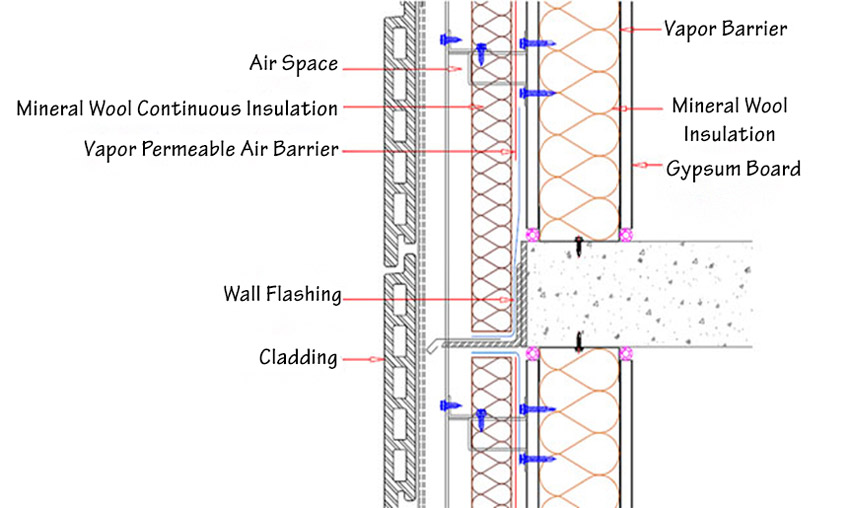Mineral Wool as a Continuous Insulation Solution
Mineral Wool's Relationship to Standards and Codes
Below are the key codes and standards that define system interaction and key specification practices, designed to ensure that wall system designs are consistent with recent advances in building analysis, new code requirements, revised test methods, and a comprehensive systems approach to wall systems.
- NFPA 285: NFPA 285 is required in the International Building Code (IBC) in multiple situations. The NFPA 285 test is to determine that combustibles, when exposed to fire on the exterior face of the wall, do not spread flame over the surface or through the core of the otherwise noncombustible wall assembly.
- ASHRAE 90.1: ASHRAE 90.1 is a baseline building energy standard that may be adopted by states and local jurisdictions to regulate the design and construction of new buildings. The mandatory installation of ci over steel stud framing was first incorporated in the ASHRAE 90.1-1999 edition. Both residential and nonresidential commercial steel-framed walls in zones 3–8 required continuous insulation. Standard 90.1-2013 prescribes ci in all climate zones for steel frame construction and metal-framed buildings.
- International Energy Conservation Code (IECC): IECC addresses both residential and commercial buildings (90.1 is limited to commercial buildings).
Beyond the Code: Reducing Greenhouse Gas Emissions
Another important factor in increasing energy efficiency in buildings is reducing greenhouse gas emissions. According to a 2007 McKinsey study titled “Reducing U.S. Greenhouse Gas Emissions: How Much and at What Cost,” new commercial and residential building envelope improvements (including increased insulation levels) are identified as a negative marginal cost item—meaning that this option would generate “positive economic returns over its life cycle.” Many industry professionals feel that the insulation requirements set out in state-adopted codes are not enough to save energy and reduce greenhouse gas emissions. They look beyond the code initiatives to USGBC’s LEED rating system as well as ASHRAE Standard 189 or Architecture 2030.
Mineral Wool Insulation and LEED
In terms of mineral wool insulation’s potential product contributions to LEED, the following overview illustrates the benefits of the product in the Energy & Atmosphere, Materials & Resources, and Indoor Environmental Quality categories.
Energy & Atmosphere (EA)
Minimum Energy Performance Prerequisite 2
Mineral wool insulation helps reduce building energy demand. The project team is responsible for conducting energy analysis to determine the overall building energy efficiency.
Optimize Energy Performance
Mineral wool insulation helps reduce building energy demand. It’s dependent on U-value of construction assembly. The project team is responsible for conducting energy analysis to determine the overall building energy efficiency.
Materials & Resources (MR)
Building Product Disclosure & Optimization – Environmental Product Declaration
This credit calls for the use of 20 different permanently installed products sourced from at least five different manufacturers that have third-party certified EPD. Mineral wool insulation products carry third-party certified EPDs. See UL.com/EPD for certifications.
Raw Material Source and Extraction Reporting
Mineral wool insulation manufacturing plants extract raw materials and manufacture products in close proximity to many projects. The products may contain various levels of preconsumer recycled content. Some products have higher content, so check with manufacturers.
Building Product Disclosure and Optimization Material Ingredients
This credit also calls for the use of at least 20 different permanently installed products from at least five different manufacturers that demonstrate the chemical inventory of the product to at least 0.1 percent (1,000 ppm). Various mineral wool insulation products have material disclosure information such as Declare, Cradle to Cradle (at least Bronze), or Cradle to Cradle Material Health Certification (Bronze or higher), and at least 90 percent of materials are assessed by weight.
Construction and Demolition Waste Management
This credit considers the recycle or salvage of nonhazardous construction and demolition materials. Mineral wool insulation material can be removed from demolition projects and reused in new construction. Refer to manufacturer product specifications for recommended storage and installation of materials, specifications for recommended storage, and installation of materials.
Indoor Environmental Quality (EQ)
Thermal Comfort
Design HVAC systems and building envelope to meet ASHRAE Standard 55–2010: Thermal Comfort Conditions for Human Occupancy with errata or a local equivalent. Mineral wool insulation products contribute to a comfortable thermal environment.
Low Emitting Materials (EQ)
This credit includes requirements for product manufacturing as well as project teams. It covers volatile organic compound (VOC) emissions in the indoor air and the VOC content of materials, as well as the testing methods by which indoor VOC emissions are determined. The introduction of mineral wool made without formaldehyde addresses this credit area.
Mold Resistance
Mineral wool insulation products do not promote mold growth when tested in accordance with ASTM standards. See individual product data sheets for details.
Indoor Environmental Quality (EQ) – For Schools Only
Minimum Acoustic Performance Prerequisite 3
Mineral wool insulation products absorb noise passing between floors and walls and provide STCs that improve the indoor environmental quality through acoustical performance for building occupants.
Acoustic Performance
Mineral wool insulation products absorb noise passing between floors and walls and provide STCs that improve the indoor environmental quality for building occupants. This can contribute to design of classrooms and other core learning spaces to meet the sound transmission class (STC) requirements of ANSI S12.60–2010 Part 1 or a local equivalent.
Acoustics
One attribute that mineral wool products provide is sound attenuation. Mineral wool has a long history of success with improving indoor acoustics. All mineral wool insulation blocks and absorbs sound passing between partition walls and floor/ceiling applications. Assemblies that include mineral wool are capable of providing sound transmission coefficients (STCs) that improve the indoor environmental quality for the occupants of a structure. Furthermore, it could be surmised that using insulation with sound-control properties on the exterior of the building can help to improve the indoor environmental quality by reducing the amount of noise coming in from outside the building.
The chart below describes the noise reduction coefficient of different thicknesses of a typical mineral wool. The NRC is a number used for rating how a particular material absorbs sound. It is determined through laboratory testing. The number ranges from zero (perfectly reflective) to 1 (perfectly absorptive), and some materials can test above 1.

Rinscreen and Cavity Wall Assemblies
One of the prime uses of mineral wool insulation is in rainscreen and cavity wall designs. Commonly used in Europe, these assemblies create an air/drainage cavity that prevents water ingress and allows pressure equalization. There are a number of options for mineral wool insulation use in a rainscreen design. It can be used in both permeable and nonpermeable assemblies. The graphic below illustrates a vapor permeable design.

This next image is an example of a vapor nonpermeable assembly. Vapor retarders, air barriers, and moisture control are elements that are essential to the proper design and construction of buildings.

The need for, and proper placement of, the vapor/air barrier and moisture control must be determined by a qualified professional engineer/architect. Critical considerations include the inside and outside climatic and air pressure conditions of the building. In addition, any penetrations of the vapor/air barrier for mechanical insulation attachment must be approved by the air/vapor barrier manufacturer.
Below is an example of an open-joint assembly. Here, the use of UV-resistant mineral wool is for the durability of the assembly and no loss of R-value. Walls without ci are subject to up to 50 percent loss of effective R-value.










